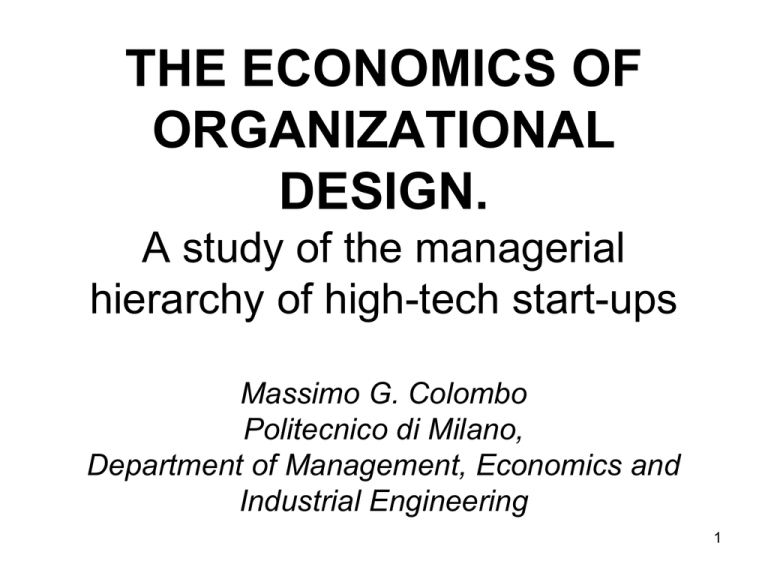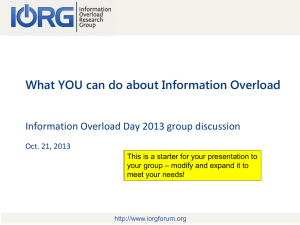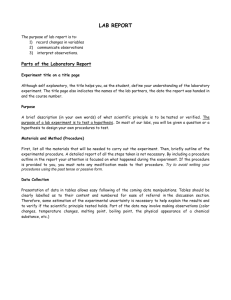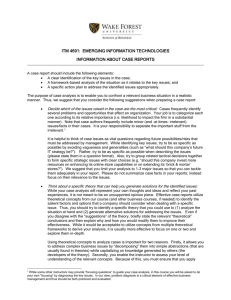On the managerial professionalization of high-tech start-ups:
advertisement

THE ECONOMICS OF ORGANIZATIONAL DESIGN. A study of the managerial hierarchy of high-tech start-ups Massimo G. Colombo Politecnico di Milano, Department of Management, Economics and Industrial Engineering 1 THE ECONOMICS OF ORGANIZATIONAL DESIGN Massimo G. Colombo & Marco Delmastro 2 Objective of the book • Popular approach to the study of the organization of firms (John Roberts, The modern firm, 2004): it typically mixes: – real facts based on anecdotal business evidence and case studies – with conceptual and theoretical insights. • Key weakness: lack of a generalizable framework. • Aim of the book: – Provide a framework grounded in economic theory in which firms’ organization can be quantitatively analyzed in a multidimensional space; – Focus attention on a limited set of key dimensions of organizational design: allocation of power, corporate hierarchy, incentive structure, & management practices; – Analyze variations across firms and over time of these key dimensions; – Use this evidence to assess empirically the explanatory power of arguments proposed by the theoretical literature. 3 Content of the book • Provide a systematic review of the existing quantitative empirical evidence on (selected dimensions of) organizational design coming from disciplines as diverse as industrial economics, personnel economics, business history, organization and management studies, industrial relations, and sociology. • Propose a new empirical framework aimed at defining (a limited set of) standardized quantitative indicators of organizational design that are suitable to be used in econometric work. • Use the stylized facts that result from both existing quantitative empirical studies and our framework to test theoretical predictions that are derived from the theoretical economic literature about the determinants of organizational design, its evolution and its effects on firm performance. 4 On the managerial professionalization of hightech start-ups: the determinants of the creation of a middle-management level Massimo G. Colombo & Luca Grilli Politecnico di Milano, Department of Management, Economics, and Industrial Engineering 5 Objective of the paper • Number of levels (depth) of the management hierarchy: key characteristic of organizational design (Simon, 1945; Colombo and Delmastro, 2008) • Growing interest from the theoretical literature in economics (e.g. Williamson 1967; Keren and Levhari 1979, 1983; Radner 1992, 1993; Bolton and Dewatripont 1994; Qian 1994; Van Zandt 1998; Garicano 2000; Garicano and Rossi-Harsberg, 2006) • Lack of large-scale quantitative empirical evidence on its determinants (in spite of early work in the 1960s and 1970s: e.g. Aston group, Child 1973). • With few exceptions (Wang 2006), available quantitative evidence mostly confined to large firms (Rajan and Wulf 2006). 6 • Focus on independent (owner-managed) new technology-based firms (NTBFs). • Econometric analysis of the decision of ownermanagers to introduce an intermediate management level into firm’s organization and to partially delegate decision authority downward the corporate hierarchy: – Why do some NTBFs appoint a salaried middle manager more rapidly than other NTBFs? • Small across-firm heterogeneity: more precise test of the predictions of different streams of the theoretical economic literature. 7 The benefits from the creation of a middle management level (I) • Information processing stream: – Reduction of information overload of ownermanagers (Sah and Stiglitz 1986; 1988); – Reduction of delay in decision making (Radner 1992; Van Zandt 1998); – Knowledge hierarchy: Specialization of decision tasks between owner-managers and middle managers (Bolton and Dewatripont 1994; Garicano 2000; Harris and Raviv 2002; Garicano and Rossi-Harsberg 2006). 8 The benefits from the creation of a middle management level (I) • Decentralization of incentive stream: – Better monitoring of line workers (Calvo and Wellisz 1978); – Delegation allows: • To take advantage of middle managers’ specific knowledge (Aghion and Tirole 1997; Baker et al. 1999; Raith 2005); • To motivate the newly appointed middle manager(Van den Steen 2006). 9 The costs from the creation of a middle management level (I) • Decentralization of incentive stream: – Loss of control by owner-managers over decisions that are delegated to middle managers (Aghion and Tirole 1997); – Greater costs: • The less aligned middle managers’ objectives are with those of owner-managers; • The more difficult it is for owner-managers to monitor middle managers’ behavior. • The greater the potential losses to the firm from middle managers’ opportunistic behavior. 10 Labor market conditions • Imperfections in the labor market make it difficult for NTBFs to hire skilled middle managers: – Information asymmetries (adverse selection); need for credible signals of firm’s quality; – Commitment of relation specific investments by middle managers & high switching costs in the labor market; – High search costs for candidates. 11 Theoretical predictions Information processing Decentraliz. of incentives Firm size + (info overload) + (monitoring) + Firm growth + (info overload) + (monitoring) + Firm age Labor market Total effect + (info asymmetries N. founders (info overload) - (monitoring) Management competencies (info overload) - (monitoring) + (signal) ? 12 Theoretical predictions Information processing Decentraliz. Labor market Total of incentive effect Founders’ human capital + (knowledge hierarchy) + (signal) + Heterogeneity of founders’ competencies (info overload) + (transaction costs) ? VC-backed + (loss of control) + (signal/ transaction costs) + Innovation output (loss of control) + (signal) ? 13 Theoretical predictions Information processing Decentraliz. of incentive Labor market Total effect Competition + (urgency) + (loss of control) + (switching costs) + Differentiation (urgency) (loss of control) (switching costs) - (info asymmetries) - Uncertainty Appropriability Control: Local education endowment + (loss of control) + + (switching costs /transaction costs) + 14 The sample • 524 Italian NTBFs: • • • • Established in 1980 or later; Independent; Having survived up to the end of 2003; In high-tech industries in manufacturing and services; • Representative of a population of 1974 firms (RITA Directory). • Surveyed in 2000, 2002 and 2004. 15 • Hand-collected longitudinal dataset: • Data on managerial professionalization: dates of the appointment of the first salaried manager; • Firm-specific data relating to the 1994-2003 period: firm size (number of employees, sales); • Data on VC financing: dates of investment rounds, type of investor (FVC, CVC); • Data on other firm-specific characteristics (e.g. human capital of founders); • Data on industry- and location-specific characteristics. • Methodology of the econometric analysis: • Survival data analysis model: hazard rate of hiring the first salaried middle manager (Weibull and Cox models) • Probit analysis for robustness (see infra) 16 Descriptive statistics/1 Descriptive statistics/2 18 Smoothed hazard rate of 1° manager introduction 19 Results of the estimates/1: Survival 20 Results of the estimates/2: Survival 21 Results of the estimates/3: Probit 22 Comparison with theoretical predictions/1 Information processing Decentraliz. of incentive Firm size + (info overload) + (monitoring) + Firm growth + (info overload) + (monitoring) + Firm age Labor market Total effect + (info asymmetries) N. founders (info overload) (monitoring) Management competencies (info overload) (monitoring) + (signal) ? 23 Comparison with theoretical predictions/2 Information processing Decentraliz. of incentive Labor market Total effect Founders’ human capital + (knowledge hierarchy) + (signal) + Heterogeneity of founders’ competencies (info overload) + (transaction costs) + IVC-backed (does not hold for CVC-backed) + (loss of control) + (signal/ transaction costs) + Innovation output (loss of control) + (signal) ? 24 Comparison with theoretical predictions/3 Information processing Decentraliz. of incentive Labor market Total effect Competition + (urgency) + (loss of control) + (switching costs) + Differentiation (urgency) (loss of control) (switching costs) - (info asymmetries) - Uncertainty Appropriability Control: local education endowment + (loss of control) + (switching costs/transaction costs) + 25 Conclusions • Research question: – What determines the likelihood of a ownermanaged NTBF appointing a salaried middle manager and (partially) delegating decision authority to her? • Estimates based on a sample of 524 Italian NTBFs observed from foundation. 26 Result n. 1 • Econometric results in line with the predictions of both the information processing and decentralization of incentives streams of theoretical literature. • Key determinant: size of firm’s operations: – A) Information overload; – B) Difficult to monitor workers. • (A) creates more severe problems in a highly competitive environment, where decision delays are very detrimental to the firm. • Weak evidence that (A) and (B) are more difficult to be dealt with when there are few owner-managers and they lack entrepreneurial and managerial experience. 27 Results n. 2 • NTBF as a “knowledge hierarchy”: – the greater the human capital of owner-managers and the greater the opportunity cost of their time, the more likely the appointment of a salaried middle manager; – Delegation of operating tasks to middle managers allows to capture the benefits from “specialization of tasks” between owner-managers and salaried middle managers. 28 Results n. 3 • Loss of control : – Weak evidence in support of the argument that the extent of loss of control problems deters appointment of a salaried middle manager; – No evidence that loss of control problems depend negatively on the appropriability regime of technology and positively on the technological position of the focal NTBF; – If benchmarking is difficult (e.g. differentiated products sold in markets with few competitors) loss of control problems might deter appointment of a salaried middle manager; – But these results may depend on other effects (urgency, swithching costs in the managerial labor market). 29 Result n. 4 • Importance of transaction costs and adverse selection problems in the market for middle managers: the likelihood of the creation of a middle management level: – Increases with firm age; – Decreases with the uncertainty of the business environment. – Increases with the business contacts of owner-managers. • Evidence as to the role of “signals” of firm’s quality: – Positive effect of the human capital of owner-managers (possibly because of the “knowledge hierarchy” argument); – Positive effect of IVC (possibly because of the positive effect of the reduction of loss of control problems). – No effect of CVC (pointing to the different nature of this investor) 30






